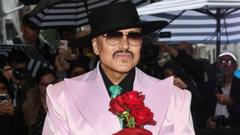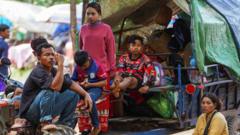In Romania, the traditional embroidered blouse, known as “ie,” has become a symbol not only of cultural pride but also of political contention. Once celebrated for its folkloric beauty, the blouse has found a new audience among nationalist politicians who wear it as a statement of their commitment to national traditions. This emerging trend has sparked backlash from liberal factions, claiming that the larger cultural heritage it represents belongs to all Romanians, not just nationalists.
High-profile figures like Diana Sosoaca, a far-right politician, and George Simion, a recent presidential candidate, are among those who have embraced the blouse as part of their public personas. Sosoaca is rarely seen without it, while Simion has garnered significant support with his affinity for the garment. In a particularly vivid campaign moment, ultranationalist Calin Georgescu, now a controversial figure, showcased the blouse in viral TikTok videos that featured him clad in traditional attire while riding a horse.
The blouse is not merely a garment; it represents a connection to Romania's rich cultural and historical landscape. The intricate designs featured on each piece are often painstakingly embroidered over months, creating a tapestry of stories from the past. Craftspeople in rural areas, like Daniel Stanciu, have turned the production of these blouses into viable small businesses, drawing on local seamstresses to keep the tradition alive.
As nationalists adopt the blouse for political gain, questions arise about cultural appropriation and the ownership of a shared identity. Critics argue that the politicization of the blouse risks erasing its communal significance and turning it into a mere political prop. Supporters assert that wearing the blouse is an expression of pride in Romanian heritage. The ongoing debate continues to highlight the delicate balance between celebrating tradition and fostering a sense of national unity without marginalizing the collective history that belongs to all Romanians.
High-profile figures like Diana Sosoaca, a far-right politician, and George Simion, a recent presidential candidate, are among those who have embraced the blouse as part of their public personas. Sosoaca is rarely seen without it, while Simion has garnered significant support with his affinity for the garment. In a particularly vivid campaign moment, ultranationalist Calin Georgescu, now a controversial figure, showcased the blouse in viral TikTok videos that featured him clad in traditional attire while riding a horse.
The blouse is not merely a garment; it represents a connection to Romania's rich cultural and historical landscape. The intricate designs featured on each piece are often painstakingly embroidered over months, creating a tapestry of stories from the past. Craftspeople in rural areas, like Daniel Stanciu, have turned the production of these blouses into viable small businesses, drawing on local seamstresses to keep the tradition alive.
As nationalists adopt the blouse for political gain, questions arise about cultural appropriation and the ownership of a shared identity. Critics argue that the politicization of the blouse risks erasing its communal significance and turning it into a mere political prop. Supporters assert that wearing the blouse is an expression of pride in Romanian heritage. The ongoing debate continues to highlight the delicate balance between celebrating tradition and fostering a sense of national unity without marginalizing the collective history that belongs to all Romanians.


















